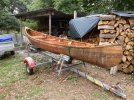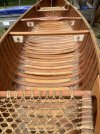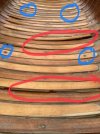Thanks for letting me join.
Lived and canoed in UK then sold up and moved to Brittany, France.
Mentioned to a french friend that I was missing canoeing and he produced the boat shown. It has been stored outside, upside down on its trailer, for more than 4 years. He thinks it was bought in Canada and brought to France quite a while ago.
Any help with identifying the boat would be greatly appreciated.
Any guidance, or links to guidance, on how best to replace the rotten outwales and reglue the floorboards would be wonderful.
Many thanks in anticipation.
Andy in France
Lived and canoed in UK then sold up and moved to Brittany, France.
Mentioned to a french friend that I was missing canoeing and he produced the boat shown. It has been stored outside, upside down on its trailer, for more than 4 years. He thinks it was bought in Canada and brought to France quite a while ago.
Any help with identifying the boat would be greatly appreciated.
Any guidance, or links to guidance, on how best to replace the rotten outwales and reglue the floorboards would be wonderful.
Many thanks in anticipation.
Andy in France



